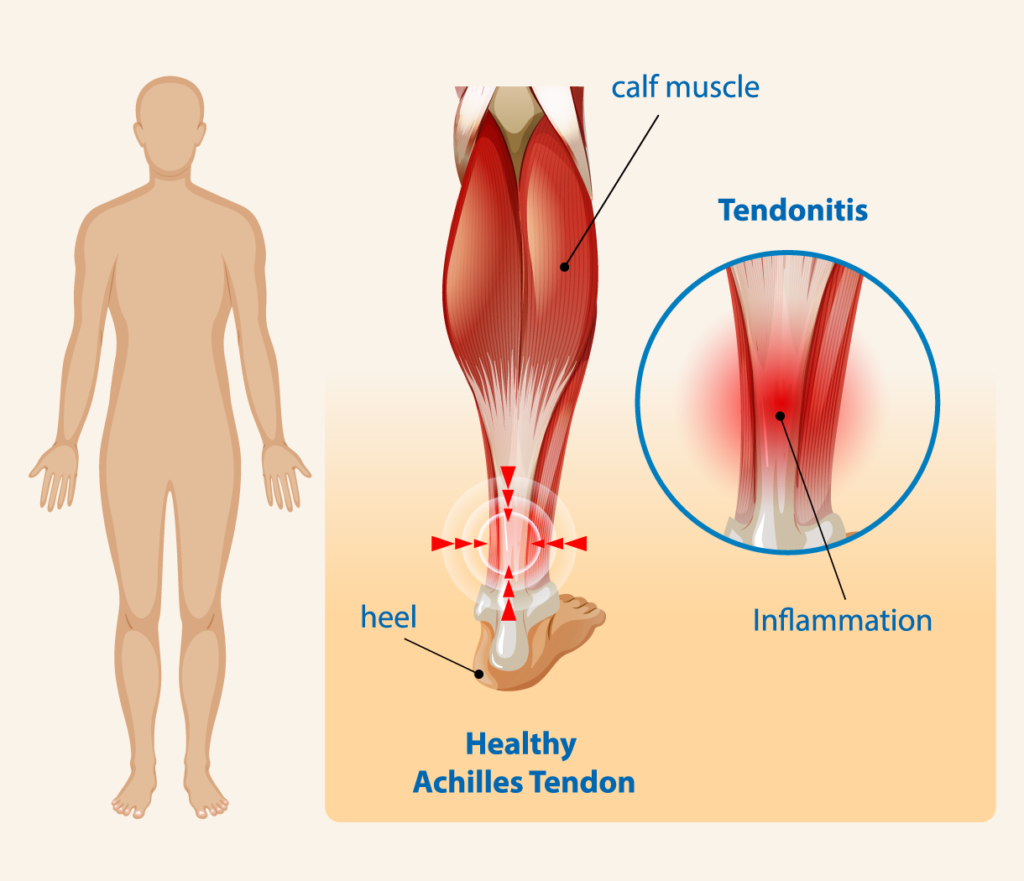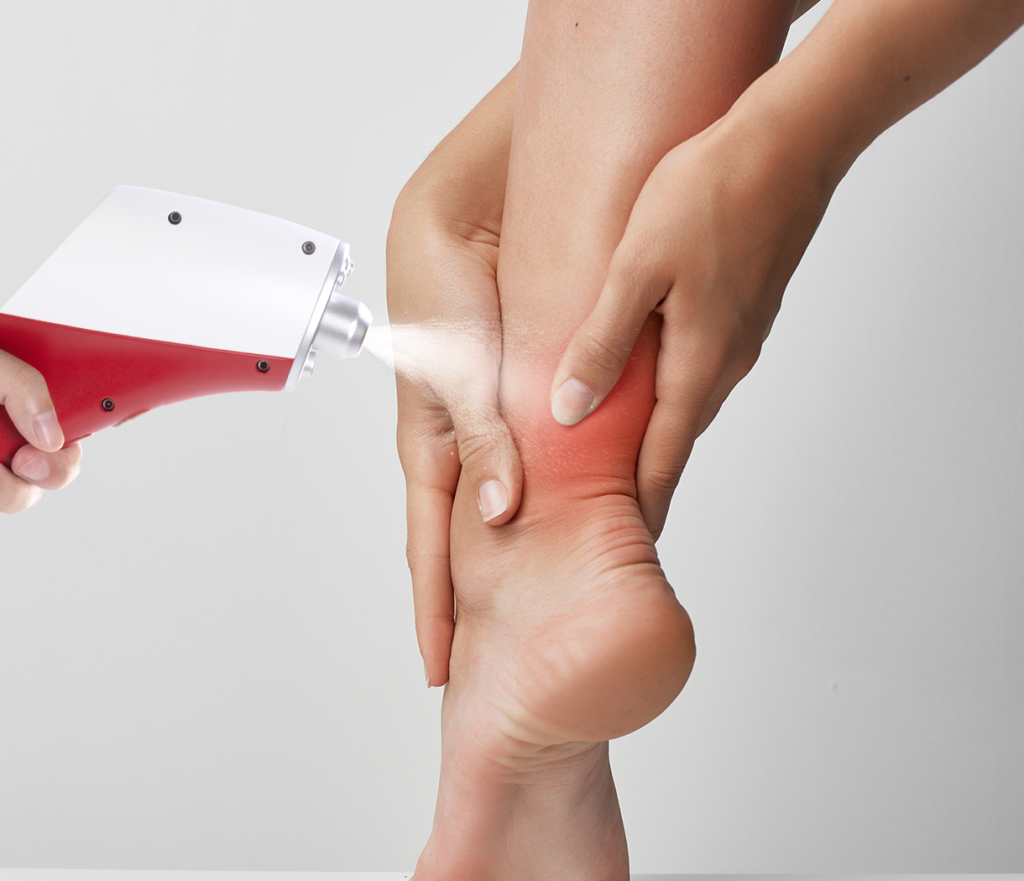Introduction: Understanding Tendon Injuries and the Need for Effective Treatment
Tendon injuries are common in sports and orthopedic care, ranging from minor strains to severe ruptures. These injuries often cause prolonged pain and functional impairment due to tendons’ poor blood supply and slow healing. Traditional treatments like RICE, NSAIDs, and physical therapy may not always promote optimal healing, as some suppress necessary inflammatory responses. This has led to the exploration of more effective therapies, with CO₂ cryotherapy emerging as a promising option. By using carbon dioxide at extremely low temperatures, CO₂ cryotherapy offers controlled cooling that penetrates deeper into tissues and provides more consistent therapeutic effects than traditional ice. This advanced cryotherapy technique addresses multiple aspects of tendon injury recovery, making it an ideal treatment for both acute and chronic conditions.
What Are Tendon Injuries?
Tendon injuries encompass a spectrum of pathological conditions affecting the dense connective tissue structures that connect muscles to bones, facilitating the transmission of muscular forces to create joint movement. These injuries can be classified into acute traumatic injuries, such as tendon ruptures or tears resulting from sudden excessive force, and chronic degenerative conditions, known as tendinopathies, which develop gradually through repetitive stress and microtrauma. Acute tendon injuries typically involve mechanical failure of tendon fibers due to forces exceeding the tissue’s tensile strength, often occurring during explosive movements or sudden directional changes. Chronic tendinopathies represent a more complex pathological process involving collagen degeneration, neovascularization, and neural sensitization that results in persistent pain and functional impairment. The healing process in tendons is inherently slow due to their hypovascular nature, with the central portions of many tendons receiving minimal blood supply, relying primarily on diffusion for nutrient delivery and waste removal.
Common Causes and Symptoms of Tendon Injuries
Common Causes of Tendon Injuries:
Overuse and Repetitive Strain: Activities like running, jumping, or throwing cause cumulative microtrauma, leading to tendinopathy.
Age-related Changes: As people age, tendons lose collagen and become more vulnerable to injuries, even with minor trauma.
Biomechanical Factors: Muscle imbalances, poor technique, and improper training loads can increase the risk of tendon injuries.
Acute Traumatic Injuries: Sudden excessive loading, especially during eccentric muscle contractions, can cause tendon tears or ruptures.
Symptoms of Tendon Injuries:
Pain: Pain is often sharp or aching and worsens with continued activity or use of the affected area.
Swelling and Tenderness: The affected tendon or joint becomes swollen and tender to the touch.
Stiffness: Stiffness occurs, particularly after periods of rest or inactivity, such as in the morning.
Functional Impairment: Strength and range of motion are often reduced in the affected area, making movement difficult.
Morning Stiffness: Tendons may feel stiff in the morning but loosen up with light activity, although the pain may return with prolonged use.
Chronic Tendinopathies: Symptoms develop gradually, with pain worsening over time if not addressed.

The Role of Cryotherapy in Injury Treatment
CO₂ cryotherapy is an advanced treatment that uses carbon dioxide gas at extremely low temperatures to create controlled cooling on target tissues. Developed by Cryonic in 1993, the method involves spraying microcrystals of CO₂ at -78°C (-108°F) under high pressure (50 bars) to the painful area. The system rapidly expands compressed CO₂ gas through specialized nozzles, creating frozen microcrystals for rapid and deep tissue cooling. The high-pressure gas cylinders are connected to control units that regulate flow rate, pressure, and timing. Treatments typically last 10-15 seconds per area, allowing multiple sites to be treated in one session. The cooling is followed by quick rewarming, triggering beneficial physiological responses. Unlike traditional ice therapy, CO₂ cryotherapy provides consistent temperature control, avoids the frostbite risk from direct ice contact, and enables precise treatment of irregular or hard-to-reach areas.
The Science Behind CO₂ Cryotherapy for Tendon Injuries
The scientific foundation of CO₂ cryotherapy rests on advanced understanding of thermal therapy mechanisms and their specific effects on tendon tissue physiology. This sophisticated approach to cold therapy represents a significant evolution from traditional cryotherapy methods, incorporating precise temperature control and targeted application techniques that can address the complex pathophysiology of tendon injuries more effectively than conventional cooling methods.
What is CO₂ Cryotherapy?
CO₂ cryotherapy is an advanced treatment that uses carbon dioxide gas at extremely low temperatures to provide localized cooling for tissue relief. Developed by Cryonic in 1993, it sprays microcrystals of CO₂ at -78°C (-108°F) under high pressure (50 bars) onto the painful site. The system rapidly expands compressed CO₂ through specialized nozzles, creating frozen microcrystals for precise, controlled cooling. The treatment typically lasts 10-15 seconds per site, with multiple areas treated in one session. The rapid cooling followed by quick rewarming triggers beneficial physiological responses, such as reduced pain and inflammation. Unlike traditional ice therapy, CO₂ cryotherapy offers consistent temperature delivery, reduces frostbite risk, and allows for precise treatment of irregular or hard-to-reach areas.
How CO₂ Cryotherapy Works on Tendon Injuries
The therapeutic mechanisms of CO₂ cryotherapy for tendon injuries involve complex physiological processes that address both the immediate symptoms and underlying pathophysiology of tendon damage. The rapid temperature reduction achieved through CO₂ application creates an immediate vasoconstriction response, reducing local blood flow and potentially limiting secondary inflammatory damage. However, the brief application duration followed by rapid rewarming triggers a subsequent vasodilation phase that can enhance circulation and promote healing. This biphasic vascular response differentiates CO₂ cryotherapy from prolonged ice application, which may cause sustained vasoconstriction that could impair healing.
The Cold Effect: Reducing Inflammation and Pain
CO₂ cryotherapy at -78°C rapidly cools tissues, reducing nerve conduction velocity and providing immediate pain relief. This cold effect inhibits pain through neural inhibition and activation of the gate control mechanism. Cryotherapy also downregulates PGE2, a key inflammatory mediator in tendon injuries, reducing pain and vasodilation. The cooling reduces cellular metabolism and enzyme function, particularly affecting cyclooxygenase pathways responsible for prostaglandin synthesis. This modulation reduces inflammation while preserving tissue healing capacity. The short application prevents excessive metabolic suppression, allowing cellular repair to continue. Additionally, cold therapy activates endogenous pain modulation systems, releasing endorphins and engaging descending pain pathways, which provide long-lasting pain relief beyond the immediate treatment.
Increased Blood Flow for Faster Healing
After initial vasoconstriction from cold, CO₂ cryotherapy triggers a vasodilation phase that boosts blood flow to the injury site. This increased circulation brings oxygen, nutrients, immune cells, and removes metabolic waste, crucial for tendon healing due to limited vascularity. The thermal shock stimulates the release of nitric oxide and other vasoactive substances, improving local microcirculation and promoting tissue repair. This enhanced circulation delivers growth factors and cytokines necessary for regeneration without causing prolonged inflammation. The precise treatment duration ensures optimal blood flow stimulation while minimizing potential negative effects from excessive thermal stress.
The Role of Cryotherapy in Tendon Repair and Regeneration
CO₂ cryotherapy goes beyond symptom relief to actively promote tendon repair and regeneration through several biological mechanisms. The brief, intense cooling stimulates cellular stress responses, enhancing heat shock protein production and cytoprotective factors that maintain cellular integrity and support tissue remodeling. Changes in circulation also optimize the delivery of stem cells and reparative cells to the injury site. Tendon and ligament injuries, with their poor blood supply and chronic inflammation, benefit from CO₂ cryotherapy’s ability to reduce inflammation and enhance vascular response. By lowering prostaglandin levels, cryotherapy helps prevent chronic inflammation, which can hinder healing. The cooling effect also activates mechanotransduction pathways, encouraging collagen synthesis and proper fiber alignment. Additionally, cryotherapy’s neurological effects, such as temporary denervation of pain pathways, reduce movement restriction and facilitate earlier return to activity, promoting optimal tendon healing and remodeling.
Benefits of CO₂ Cryotherapy for Tendon Injury Recovery
The therapeutic benefits of CO₂ cryotherapy for tendon injury recovery encompass both immediate symptomatic relief and long-term healing advantages that make it a valuable addition to comprehensive treatment protocols. These benefits arise from the unique physiological responses triggered by the controlled application of extreme cold, creating conditions that optimize both pain management and tissue healing processes.
Faster Pain Relief and Reduced Swelling
CO₂ cryotherapy provides rapid pain relief through multiple neurophysiological mechanisms. The extreme cold reduces nerve conduction velocity, creating immediate analgesia and lasting relief. Large-diameter mechanoreceptors trigger the gate control mechanism, blocking pain signals at the spinal cord level. Cryotherapy also reduces prostaglandin E2, a key mediator of pain and inflammation in tendons. Swelling is minimized through vasoconstriction, which lowers capillary permeability and fluid accumulation. The brief cooling duration prevents rebound swelling, while the vasodilation phase helps clear inflammatory fluid via enhanced lymphatic drainage. Many patients experience significant pain reduction within minutes, with effects lasting several hours, improving sleep quality and daily function.
Enhanced Recovery Time for Athletes and Active Individuals
For athletes and active individuals, CO₂ cryotherapy accelerates recovery and reduces downtime, allowing for quicker return to activity. The controlled temperature and brief treatment duration prevent numbness and stiffness, enabling immediate return to light activities. The enhanced blood flow that follows cryotherapy promotes nutrient delivery and waste removal, reducing recovery time compared to traditional rest-based approaches. Pain relief allows earlier initiation of mobility exercises, essential for tendon healing. Treatment can be repeated multiple times daily, offering flexibility around training and competition schedules. Athletes using CO₂ cryotherapy may return to full activity 20-30% faster than those using conventional treatments.
Non-invasive and Drug-Free Treatment Option
CO₂ cryotherapy is an attractive non-invasive alternative for patients seeking to avoid medications or invasive procedures. It provides effective pain relief without the systemic side effects of oral drugs, like NSAIDs, which may hinder tendon healing. Unlike corticosteroid injections, which can weaken tendons, CO₂ cryotherapy can be applied multiple times without adverse effects. The treatment eliminates the risks of infection, bleeding, and nerve damage associated with injections. It’s safe for patients with allergies, drug interactions, or other health conditions, including during pregnancy and for children. CO₂ cryotherapy integrates well with physical therapy, offering a natural healing approach with no concerns about medication dependency.
Long-term Benefits for Chronic Tendon Pain
CO₂ cryotherapy is particularly effective for chronic tendon pain, breaking the pain-inflammation cycle that perpetuates long-term symptoms. It helps reset sensitized pain pathways, reducing central sensitization. Regular treatments reduce prostaglandin production, addressing chronic inflammation. Improved circulation after each session promotes better tissue nutrition and waste removal, potentially reversing degenerative changes in chronic tendinopathy. By reducing pain and stiffness, cryotherapy allows for better engagement in rehabilitative exercises and daily activities. Long-term studies show that regular CO₂ cryotherapy improves pain, functionality, and quality of life in chronic tendon pain sufferers. It provides ongoing treatment without adverse effects, reducing the need for pain medications while maintaining functional status.
How to Use CO₂ Cryotherapy for Tendon Injuries
Proper application of CO₂ cryotherapy requires understanding of both the technical aspects of the equipment and the physiological principles underlying effective treatment. Successful outcomes depend on appropriate patient selection, precise application techniques, and integration with comprehensive treatment protocols that address all aspects of tendon injury recovery.
Proper Application Techniques for Targeting Tendon Injuries
Effective CO₂ cryotherapy for tendon injuries requires precise targeting and proper positioning. The treatment area should be cleaned, and any creams or medications removed to ensure proper gas penetration. The delivery device should be 1-2 cm from the skin, held perpendicular to the area. The entire tendon, including the proximal and distal portions, should be treated to address referred pain and compensatory stress. Apply the CO₂ stream for 10-15 seconds per site, avoiding sweeping motions to maintain consistent cooling. Multiple areas can be treated in one session, with brief intervals between applications for tissue assessment. Ensure patient comfort and muscle relaxation to avoid interference with the treatment. The practitioner should monitor the skin response and stop if adverse reactions, like excessive blanching, occur.
Frequency and Duration of Cryotherapy Sessions
The frequency and duration of CO₂ cryotherapy depend on the nature and severity of the tendon injury. For acute injuries, daily treatments for the first 3-5 days are optimal, followed by every-other-day treatments as symptoms improve. Each application lasts 10-15 seconds, with total session times ranging from 2-5 minutes. Chronic conditions may require 2-3 sessions per week for 4-6 weeks. Treatments can be repeated up to 2-3 times daily for acute cases, with 2-4 hours between sessions. Acute injuries typically require 6-12 sessions, while chronic tendinopathies may need 15-20 sessions. Adjust frequency based on patient response and functional improvements.
Combining Cryotherapy with Other Treatments for Optimal Recovery
CO₂ cryotherapy works best when integrated with comprehensive treatment plans. It can be combined with physical therapy, often performed before exercises to reduce pain and improve tolerance. Manual therapy, such as massage and joint mobilization, is more effective when done after cryotherapy due to its analgesic effects. It can also be paired with ultrasound therapy, electrical stimulation, or photobiomodulation, though timing should be carefully planned. Exercise regimens should adjust based on the pain relief cryotherapy provides, allowing progressive tendon loading. Nutritional support, such as anti-inflammatory supplements, can complement cryotherapy for healing. Patient education on activity modification and injury prevention is essential for long-term recovery.
Understanding the Safety Protocols of CO₂ Cryotherapy
Safety protocols for CO₂ cryotherapy include proper equipment checks and patient screening. Contraindications, such as cold hypersensitivity or impaired skin, should be identified before treatment. Ensure the equipment is functioning correctly, with verified gas pressure and delivery system integrity. Practitioners should wear protective gear, including eye protection and gloves. The treatment area must be well-ventilated to prevent CO₂ buildup, and patient monitoring is essential during treatment. Visual skin assessments and verbal communication ensure patient comfort. Discontinue treatment if adverse reactions occur. Post-treatment, document any skin changes or symptoms. Ensure practitioners are properly trained and certified to safely administer CO₂ cryotherapy.
Success Stories: Real-Life Experiences with CO₂ Cryotherapy
The clinical effectiveness of CO₂ cryotherapy for tendon injuries is best illustrated through real-world experiences of patients and practitioners who have incorporated this innovative treatment into their recovery and practice protocols. These success stories provide valuable insights into the practical applications and outcomes that can be achieved with proper implementation of CO₂ cryotherapy techniques.
Testimonials from Athletes and Fitness Enthusiasts
Athletes, both professional and recreational, have reported significant improvements in tendon injuries after CO₂ cryotherapy. A professional tennis player with chronic tennis elbow returned to full training in two weeks after just three sessions, compared to previous months of rest. Marathon runners with Achilles tendinopathy found the treatment “game-changing,” enabling continued training instead of rest. A collegiate basketball player with patellar tendinopathy experienced immediate pain relief that lasted hours, allowing participation in practice. CrossFit athletes appreciate CO₂ cryotherapy for treating multiple tendon issues in one session. Recreational golfers with rotator cuff tendinopathy reported improved range of motion and reduced pain, enhancing their experience. Athletes note the precision of CO₂ cryotherapy, targeting specific areas without affecting surrounding tissues. The rapid pain relief onset is frequently mentioned as a key benefit, with many athletes scheduling treatments before or after training sessions.
Case Studies of Tendon Injury Recovery with Cryotherapy
Case studies highlight the effectiveness of CO₂ cryotherapy for tendon injuries. A 45-year-old construction worker with chronic lateral epicondylitis, unresponsive to six months of conventional treatments, saw full symptom resolution after eight sessions. A recreational runner with Achilles tendinopathy experienced both symptomatic relief and structural healing after 12 sessions of cryotherapy combined with eccentric exercises. A group of five patients with rotator cuff tendinopathy saw average pain score reductions of 60% and functional improvement of 70% after six weeks. Six-month follow-up showed sustained improvements in 80% of cases. A 16-year-old gymnast with wrist tendinopathy avoided surgery and fully returned to competition following CO₂ cryotherapy. These cases show that CO₂ cryotherapy can lead to both symptom relief and functional restoration.
Why CO₂ Cryotherapy is Gaining Popularity Among Physiotherapists
CO₂ cryotherapy is increasingly popular among physiotherapists for its precision and consistency compared to traditional ice treatments. Immediate pain relief allows more effective manual therapy and earlier introduction of exercise programs. The ability to target specific anatomical areas has been valuable in complex cases involving multiple tissue types. Physiotherapists appreciate how cryotherapy reduces inflammation without affecting muscle injury or tissue remodeling. Its compatibility with other treatments allows for comprehensive rehabilitation protocols. Many practitioners report improved patient satisfaction and outcomes, with patients often requesting the treatment for its effectiveness. Additionally, CO₂ cryotherapy’s ability to provide multiple daily treatments without adverse effects enables more intensive care for acute injuries. Continuing education on CO₂ cryotherapy has gained popularity among physiotherapists to expand their treatment capabilities.

Potential Risks and Side Effects of CO₂ Cryotherapy
While CO₂ cryotherapy is generally considered safe when properly administered, understanding potential risks and side effects is essential for informed decision-making and appropriate risk management. The extreme temperatures involved in treatment require careful consideration of patient factors and proper application techniques to minimize adverse outcomes.
Are There Any Risks with CO₂ Cryotherapy for Tendon Injuries?
CO₂ cryotherapy carries some risks, primarily related to extreme cold exposure. Cold-induced injury, such as frostbite or cold burns, is rare when proper protocols (10-15 seconds per site) are followed. Individuals with poor circulation, peripheral vascular disease, or cold sensitivity may be at higher risk for cold-related injury. Sudden cold exposure may cause elevated blood pressure or heart rate, posing risks for those with cardiovascular conditions. Respiratory concerns are minimal with proper ventilation, but CO₂ can displace oxygen in poorly ventilated areas. Allergic reactions to cold are rare but possible, presenting as skin irritation or systemic symptoms. Nerve injury and skin pigmentation changes are also possible but uncommon when protocols are adhered to. Overall, the risk profile of CO₂ cryotherapy is favorable compared to alternative treatments like invasive procedures or medications.
How to Mitigate Risks During Treatment
Risk mitigation for CO₂ cryotherapy starts with thorough patient screening, including questions about cold sensitivity, circulatory issues, and medications. The treatment area should be examined for skin integrity and circulation before applying cold. Operators must be properly trained and certified to ensure safe use of equipment and adherence to protocols. Strictly follow recommended application times of 10-15 seconds per site, and monitor skin response to prevent adverse effects like excessive blanching. Ensure patient comfort and communicate throughout the treatment. Adequate room ventilation and temperature control are crucial for safety. Emergency protocols for cold injuries, cardiovascular events, or respiratory issues should be in place. Documenting treatment parameters, patient reactions, and any adverse effects helps guide future decisions and ensures patient safety.
When to Consult a Professional Before Trying CO₂ Cryotherapy
Consult a professional before using CO₂ cryotherapy, especially for individuals with complex medical histories or severe tendon injuries. Patients with cardiovascular diseases or uncontrolled hypertension should get medical clearance due to potential cardiovascular responses. Those with peripheral vascular disease, diabetes with vascular issues, or cold-related disorders like Raynaud’s phenomenon need careful assessment. Medications affecting circulation, blood pressure, or temperature regulation require evaluation for potential risks. Pregnant women, particularly in the first trimester, should consult a doctor before treatment. For severe tendon injuries or conditions like fibromyalgia, complex regional pain syndrome, or unrealistic expectations, professional evaluation is essential to ensure safe treatment selection. Legal and insurance aspects may also require professional consultation to ensure proper documentation and coverage.
Conclusion: Is CO₂ Cryotherapy the Right Choice for Your Tendon Injury Recovery?
The decision to incorporate CO₂ cryotherapy into a tendon injury treatment plan represents an important consideration that should be based on careful evaluation of individual factors, treatment goals, and available alternatives. The growing body of evidence supporting this innovative treatment modality, combined with its favorable safety profile and unique therapeutic mechanisms, makes it an attractive option for many patients seeking effective, non-invasive treatment for tendon injuries.
Recap of CO₂ Cryotherapy’s Benefits for Tendon Injuries
CO₂ cryotherapy offers significant benefits for tendon injury recovery by combining rapid pain relief, reduced inflammation, and enhanced tissue healing. The extreme cold reduces nerve conduction velocity, providing immediate analgesia and lasting pain relief. It helps control inflammation by decreasing the production of inflammatory mediators like prostaglandins, while improving circulation to the affected area, which accelerates the delivery of nutrients and removal of waste products. The treatment also stimulates biological mechanisms that promote cellular repair and regeneration, making it particularly effective for both acute and chronic tendon injuries. Additionally, CO₂ cryotherapy is non-invasive and drug-free, offering a safe alternative to pharmaceuticals or injections. The precision of cryotherapy allows for targeted treatment of specific tendon areas, minimizing the impact on surrounding tissues. For athletes and active individuals, it speeds up recovery times, enabling earlier return to training and sports activities.
Making an Informed Decision: Is Cryotherapy Right for You?
When deciding whether CO₂ cryotherapy is right for your tendon injury recovery, it’s important to consider your injury type, overall health, and treatment goals. CO₂ cryotherapy is most effective for acute and chronic tendon conditions, helping to reduce pain and inflammation while promoting faster healing. However, individuals with cardiovascular conditions, peripheral vascular disease, or cold sensitivity should consult a healthcare professional before beginning treatment. Cryotherapy is a non-invasive, drug-free treatment, making it an appealing option for those who prefer to avoid pharmaceuticals. It’s essential to understand that while CO₂ cryotherapy can be highly effective, it should be integrated into a comprehensive recovery plan, which may include physical therapy, exercise programs, and lifestyle changes. If you’re looking for a treatment that accelerates recovery and targets specific tendon areas with precision, CO₂ cryotherapy may be a beneficial addition to your healing journey.
Final Thoughts: Enhancing Your Healing Journey with CO₂ Cryotherapy
CO₂ cryotherapy represents a powerful, modern approach to tendon injury recovery. It combines the benefits of fast pain relief, reduced inflammation, and enhanced healing, offering a non-invasive, drug-free option for patients seeking effective recovery. Whether dealing with acute sports injuries or chronic tendon conditions, CO₂ cryotherapy provides targeted, controlled treatment that accelerates healing without the risk of side effects associated with medications or invasive procedures. By improving circulation and stimulating cellular repair, cryotherapy can play a crucial role in supporting long-term recovery and restoring function. For athletes and individuals committed to returning to their activities quickly, it offers a valuable tool for faster rehabilitation. Before starting treatment, ensure you understand the benefits and risks, and consult a professional to determine if cryotherapy is suitable for your specific condition. With proper use, CO₂ cryotherapy can be a game-changer in your recovery journey, helping you get back to doing what you love sooner.
FAQs: Common Questions About CO₂ Cryotherapy for Tendon Injuries
CO₂ cryotherapy reduces pain and inflammation by lowering nerve conduction velocity and decreasing the production of inflammatory mediators. The cooling also promotes improved circulation, which accelerates tissue healing and cellular repair.
While CO₂ cryotherapy is generally safe, it’s important for individuals with cardiovascular conditions, circulatory issues, or cold sensitivity to consult a healthcare provider before starting treatment.
The immediate pain relief from CO₂ cryotherapy typically lasts for several hours, and repeated sessions can offer long-term benefits for reducing chronic inflammation and speeding up recovery.
For acute tendon injuries, 6-12 sessions are typically recommended, with treatments occurring daily or every other day. Chronic injuries may require 15-20 sessions, with fewer sessions per week.
Yes, CO₂ cryotherapy provides more controlled and consistent cooling, preventing risks like frostbite, and allows targeted treatment of specific areas, offering more precise and lasting pain relief compared to traditional ice therapy.



